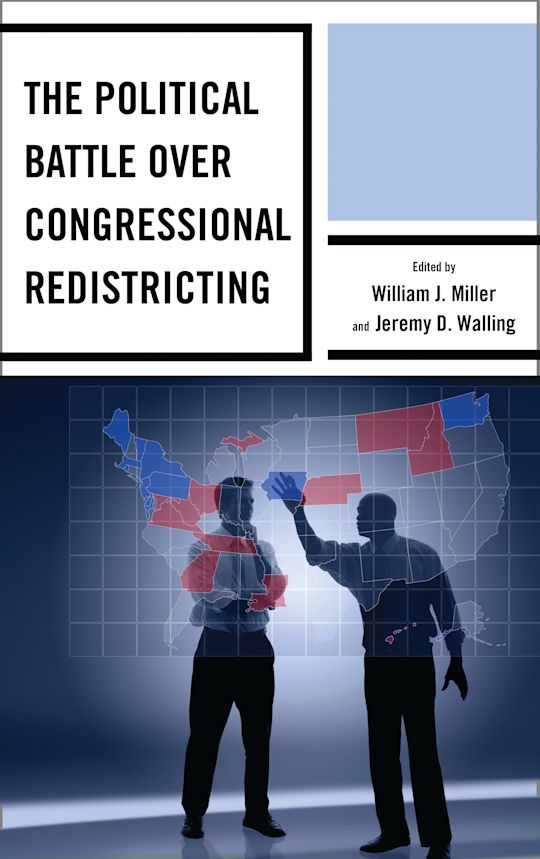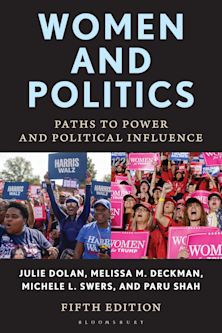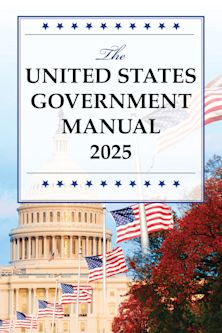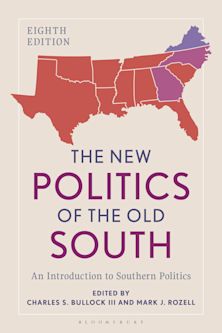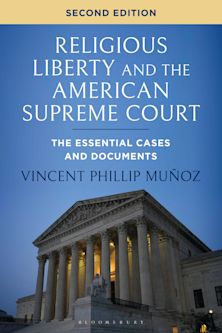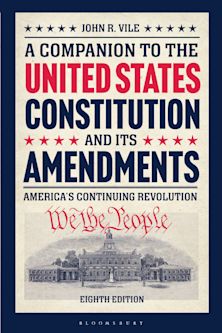- Home
- ACADEMIC
- Politics & International Relations
- American Government and Politics
- The Political Battle over Congressional Redistricting
The Political Battle over Congressional Redistricting
William J. Miller Jr. (Anthology Editor) , Jeremy D. Walling (Anthology Editor) , Rickert Althaus (Contributor) , Adam Brown (Contributor) , Charles S. Bullock III (Contributor) , Jason Casellas (Contributor) , John A. Clark (Contributor) , Álvaro J. Corral (Contributor) , Pearson Cross (Contributor) , Todd A. Curry (Contributor) , David Damore (Contributor) , Joshua J. Dyck (Contributor) , Timothy M. Hagle (Contributor) , Brigid Callahan Harrison (Contributor) , Scott H. Huffmon (Contributor) , Shannon Jenkins (Contributor) , Aubrey Jewett (Contributor) , Samantha Pettey (Contributor) , Kevin Pirch (Contributor) , Kent Redfield (Contributor) , Michael Romano (Contributor) , Ajang A. Salkhi (Contributor) , Mark Salling (Contributor) , Frederic I. Solop (Contributor) , Harry C. Strine IV (Contributor) , Russell C. Weaver (Contributor)
The Political Battle over Congressional Redistricting
William J. Miller Jr. (Anthology Editor) , Jeremy D. Walling (Anthology Editor) , Rickert Althaus (Contributor) , Adam Brown (Contributor) , Charles S. Bullock III (Contributor) , Jason Casellas (Contributor) , John A. Clark (Contributor) , Álvaro J. Corral (Contributor) , Pearson Cross (Contributor) , Todd A. Curry (Contributor) , David Damore (Contributor) , Joshua J. Dyck (Contributor) , Timothy M. Hagle (Contributor) , Brigid Callahan Harrison (Contributor) , Scott H. Huffmon (Contributor) , Shannon Jenkins (Contributor) , Aubrey Jewett (Contributor) , Samantha Pettey (Contributor) , Kevin Pirch (Contributor) , Kent Redfield (Contributor) , Michael Romano (Contributor) , Ajang A. Salkhi (Contributor) , Mark Salling (Contributor) , Frederic I. Solop (Contributor) , Harry C. Strine IV (Contributor) , Russell C. Weaver (Contributor)
You must sign in to add this item to your wishlist. Please sign in or create an account
Description
John Engler, former Governor of Michigan, once claimed that redistricting is one of the purest actions a legislative body can take. Academicians and political leaders alike, however, have regularly debated the ideal way by to redistrict national and state legislatures. Rather than being the pure process that Governor Engler envisioned, redistricting has led to repeated court battles waged on such traditional democratic values as one person, one vote, and minority rights. Instead of being an opportunity to help ensure maximum representation for the citizens, the process has become a cat and mouse game in many states with citizen representation seemingly the farthest idea from anyone’s mind. From a purely political perspective, those in power in the state legislature at the time of redistricting largely act like they have unilateral authority to do as they please. In this volume, contributors discuss why such an assumption is concerning in the modern political environment.
Table of Contents
Chapter Two: Utah: Pizza Slices, Doughnut Holes, and One-Party Dominance, Adam R. Brown
Chapter Three: Incumbency, Influence, and Race: Redistricting, South Carolina Style, Christopher N. Lawrence and Scott H. Huffmon
Chapter Four: Swimming Against the Tide: Partisan Gridlock and the 2011 Nevada Redistricting, David F. Damore
Chapter Five: Redistricting the Peach State, Charles S. Bullock, III
Chapter Six: “Fair” Districts in Florida: New Congressional Seats, New Constitutional Standards, Same Old Republican Advantage?, Aubrey Jewett
Chapter Seven: Congressional Redistricting in Louisiana: Region, Race, Party, and Incumbents, Pearson Cross
Chapter Eight: Redistricting in Massachusetts, Shannon Jenkins and Samantha Pettey
Chapter Nine: Michigan: Republican Domination during a Population Exodus, Michael K. Romano, Todd A. Curry and John A. Clark
Chapter Ten: Redistricting in Arizona: An Independent Process Challenged by Partisan Politics, Frederic I. Solop and Ajang A. Salkhi
Chapter Eleven: Carving Lines in the Cascades: Redistricting Washington, Kevin Pirch
Chapter Twelve: Missouri: Show Me...Again and Again!, Rick Althaus, Jeremy D. Walling, and William J. Miller
Chapter Thirteen: Congressional Redistricting in New Jersey, Brigid Callahan Harrison
Chapter Fourteen: Lone Star Lines: The Battle over Redistricting in Texas, Jason P. Casellas and Alvaro Corral
Chapter Fifteen: Redistricting Congressional Districts in Ohio: An Example of a Partisan Process with Long-lasting Consequences, Mark Salling
Chapter Sixteen: Raw Political Power, Gerrymandering, and the illusion of fairness: The Pennsylvania Redistricting Process, 2001 and 2011, Harry C. "Neil" Strine IV
Chapter Seventeen: Redistricting in Iowa 2011, Timothy M. Hagle
Chapter Eighteen: Drawing Congressional Districts in Illinois—Always Political, Not Always Partisan, Kent Redfield
Chapter Nineteen: New York Redistricting in Action: Legislative Inaction and Judicial Enaction, Russell C. Weaver and Joshua J. Dyck
Chapter Twenty: Why Redistricting Matters: Political Decisions and Policy Impacts, William J. Miller
Product details
| Published | 07 Jun 2013 |
|---|---|
| Format | Ebook (Epub & Mobi) |
| Edition | 1st |
| Extent | 460 |
| ISBN | 9780739169841 |
| Imprint | Lexington Books |
| Illustrations | 20 BW Illustrations, 63 Graphs, 35 Tables |
| Publisher | Bloomsbury Publishing |
About the contributors
Reviews
-
Congresspeople run for office from geographically bounded districts, and the drawing of those districts is of intense concern to politicians, parties, interested groups, the media, and the public. This book focuses on the process of drawing district lines in the 18 states that gained or lost seats in 2010. The selection of these states provides one side of the redistricting picture, ignoring intrastate population shifts in states with no changes in the number of seats. The 18 case studies are bookended by an initial contextual chapter and a brief summary chapter. . . . The introductory chapter provides some useful generalizations. . . . The final chapter largely makes the arguments that the Republicans will be favored in near future redistricting due to their success in districting state legislatures. Overall generalizations about redistricting are avoided. Most readers will find this a good archival summary of redistricting in their state if they are among the chosen 18. Summing Up: Recommended. Upper-division undergraduate, graduate, research, and professional collections.
Choice Reviews
-
A core principle of representative democracy is that the people are free to choose their leaders, but more and more, leaders are actually choosing their voters. The case studies presented here trace carefully how the redistricting process played out across the country following the 2010 census, not only testing key theories of redistricting, but also exploring the confluence of increasingly sophisticated technology and the hyper-partisan political environment. The stories are thorough without being excessive, and the mix of states creates for good generalizations. This excellent book is long overdue!
William E. Cunion, Associate Academic Dean, University of Mount Union
-
The book is a comprehensive overview of Congressional redistricting in 2011. With chapters covering 18 states, William J. Miller and Jeremy D. Walling’s collection of state experts provide an excellent account of the complexities and nuances of redistricting across the country. Each case provides details and insights that capture the political battle over Congressional redistricting. Overall, this volume brings together the interesting differences and similarities inherent in the redistricting process across the country.
Jonathan Winburn, University of Mississippi









